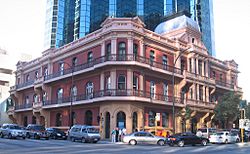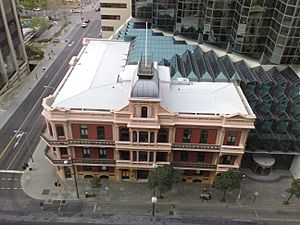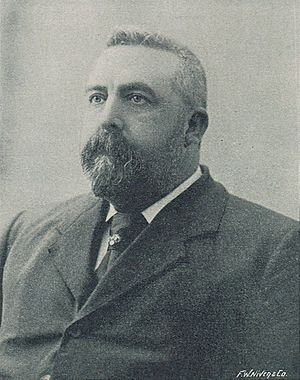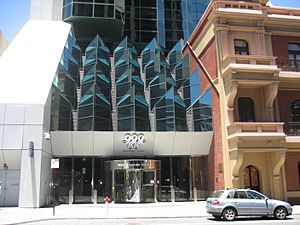Palace Hotel, Perth facts for kids
Quick facts for kids Palace Hotel |
|
|---|---|
 |
|
| General information | |
| Status | Partially demolished |
| Location | 108 St Georges Terrace Perth, Western Australia 6000 |
| Coordinates | 31°57′16.4″S 115°51′24.4″E / 31.954556°S 115.856778°E |
| Completed | 1897 |
| Design and construction | |
| Architect | Ernest Saunders Porter Edmond Neville Thomas |
| Type | State Registered Place |
| Designated | 12 May 2000 |
| Reference no. | 2114 |
The Palace Hotel in Perth, Western Australia, is a famous three-story building. It's a special landmark in the city's main business area.
It was first built in 1897 as a fancy hotel during Western Australia's exciting gold rush days. Later, in the 1980s, it changed into offices and banking rooms. Today, it's home to companies like Woods Bagot, Adapptor, and Hatchd. The building stands at a very important intersection in Perth, where St Georges Terrace meets William Street.
When the hotel first opened on March 18, 1897, people thought it was incredibly beautiful. Even though it was a bit smaller than some hotels in other big cities, it was called "one of the most beautiful and elegant hotels in Australasia." It was a working hotel from 1897 until 1981.
Contents
What Makes the Palace Hotel Special?
Its Unique Look and Style
The Palace Hotel is built in a style called Federation Free Classical. It has three stories and is made of brick and iron. Architects Porter and Thomas designed it. A rich businessman named John De Baun built it for a lot of money – about £64,000 back then. That's like A$Error when using : |start_year=1,897 (parameter 3) is lower than the earliest available year (1,901) in index "AU". million today!
Why It's a Heritage Building
In 1973, a group called the Palace Guards formed to help save the building. They wanted state planners to protect it. With help from a special protest called a green ban by construction workers, the building was added to the National Trust of Australia list in June 1973. It became a permanent heritage site in 1980. People saw it as a great example of the high-quality buildings from the gold rush era.
Later, in the 1980s, when the building was being redeveloped, many groups worked hard to keep parts of the original hotel. In 1990, new laws were made to protect heritage places. The Palace Hotel became the first building in Western Australia to have a special heritage agreement. It was officially added to the state heritage register in May 2000.
Why the Palace Hotel is Important to Perth
The Palace Hotel has always been a key landmark in Perth. This is because of its fancy style, its important location, and because it was the only building of its kind on St Georges Terrace. In its early days, it offered a luxurious and comfortable stay for business travelers. It also showed how rich and successful Western Australia was during the gold boom.
Before the Perth Town Hall was built in 1870, the land where the Palace Hotel now stands was a very important social and political spot. Big decisions, like starting a local police force in 1851, were made there. When the hotel changed into banking offices in the 1980s, many people in Perth felt a lot of fondness for its place in the city's history. Local news talked a lot about its importance.
A Look Back at the Hotel's History
The site was first used for lodging around 1830, with a place called the King's Head Hotel. In 1831, William Henry Leeder bought it, and it became Leeder's Hotel. This hotel became a popular social spot for the town. Many important dinners and parties happened there. For example, in 1833, the Perth Gazette newspaper wrote about a King's birthday party at Leeder's Hotel. Guests enjoyed nine types of meat and three desserts!
Leeder's Hotel got bigger in 1845 and was then known as the Freemasons' Tavern. It even housed the first Masonic lodge in Western Australia. After Leeder passed away, his wife handed over the management to Julian Carr. Carr was a merchant who later became a well-known local politician and led the Perth City Council. The hotel was then called the Freemasons' Hotel. Many different people ran it over the years, including the wife of future Premier Walter James.
In 1888, a fire damaged some buildings behind the hotel. The property was starting to look a bit old. In 1894, an American businessman named John De Baun bought the property for £14,000. This is like A$Error when using : |start_year=1,894 (parameter 3) is lower than the earliest available year (1,901) in index "AU". million today. He also bought other properties nearby. De Baun hired architects Ernest Saunders Porter and Edmond Neville Thomas to design the new Palace Hotel. He wanted it to be very grand, so many building materials were brought in from other places. Marble for the fireplaces and mosaic floor tiles came all the way from Italy.
The new hotel had "electric light and gas in every room." It also had electric bells and speaking tubes. It was even said to have the first lift in Perth! There were 10 bathrooms for the 50 bedrooms on the first floor. De Baun also started building the nearby Melbourne Hotel in 1895, which was similar but not quite as fancy.
John Glowrey, a member of parliament, leased the Palace Hotel from De Baun in 1901. He made the first of many changes to the building. He added more bedrooms on the north and east sides. A newspaper ad from 1903 described the hotel as the best in the state. It had 130 bedrooms, private suites, a writing room, a library, a dining hall, a grand entrance, electric lights, an elevator, and large sample rooms.
De Baun died in 1911, and the ownership went to a trust company. Glowrey continued to lease the hotel until he died in 1921. Charles Atkins bought the property in 1924 for £A 48,000. In 1930, James Henry Glowrey, a relative of the previous lessee, took over the lease. Major inside renovations costing £A 15,000 were done. This included making the bar areas bigger and turning the basement billiard room into a new bar. Outside changes were made in 1935 and 1939. In 1959, a big modernization project started, costing £A 160,000. This added air conditioning, private bathrooms, and new concrete balconies. Before this, the old name De Baun's Palace Hotel was carved above the front entrance.
The 1980s Changes

Around 1972, the Commonwealth Banking Corporation bought the hotel. They announced plans to build tall office buildings on the site. Soon after, a public campaign began. The group the Palace Guards became very active. They pushed the state government and heritage groups to save the building. Their first meeting was held at the hotel on March 27, 1973.
A professor of architecture, J.M. Freeland, wrote that the Palace Hotel was very important for Australian architecture. He said it was a great example of a fancy Victorian-era building. He believed it was the last hotel of its kind in Australia.
The fight to stop the demolition grew. The National Estates Committee spoke out against the plan. The bank even asked the Australian Government to buy the property. Finally, Bond Corporation bought the hotel and the nearby Terrace Arcade in 1978. In 1980, they showed plans for a modern office block. This plan involved tearing down parts of the old hotel and other buildings. The developers got permission to use the Palace Hotel as a bank instead of keeping it as a public hotel.
The plans for the redevelopment were described in the Trust News journal. They included:
- Building a tall, multi-use tower on one corner of the site.
- Keeping the main Palace Hotel structure on another corner.
- Creating a covered walkway between the two buildings, connecting William Street and St George’s Terrace.
- This meant tearing down the Terrace Arcade building.
- It also meant tearing down and rebuilding the hotel's eastern bedroom wing.
- Parts of the William Street side and the dining room also had to be taken apart and rebuilt.
The tower project and the hotel's restoration were a team effort between Bond Corporation and the R&I Bank. Demolition work started in August 1981. The hotel closed in June 1986 during the demolition and construction. By August 1983, the tower's foundation and three levels of underground parking were finished. The whole project was completed in 1988. Premier Peter Dowding officially opened it in August 1989.
The redevelopment meant that much of the hotel's inside walls were removed. However, the outside walls facing the two main streets are mostly still there. The William Street side is a little shorter now. A glass-covered area connects the new tower to the old hotel. This means the tower entrances also provide covered access to the historic building.




